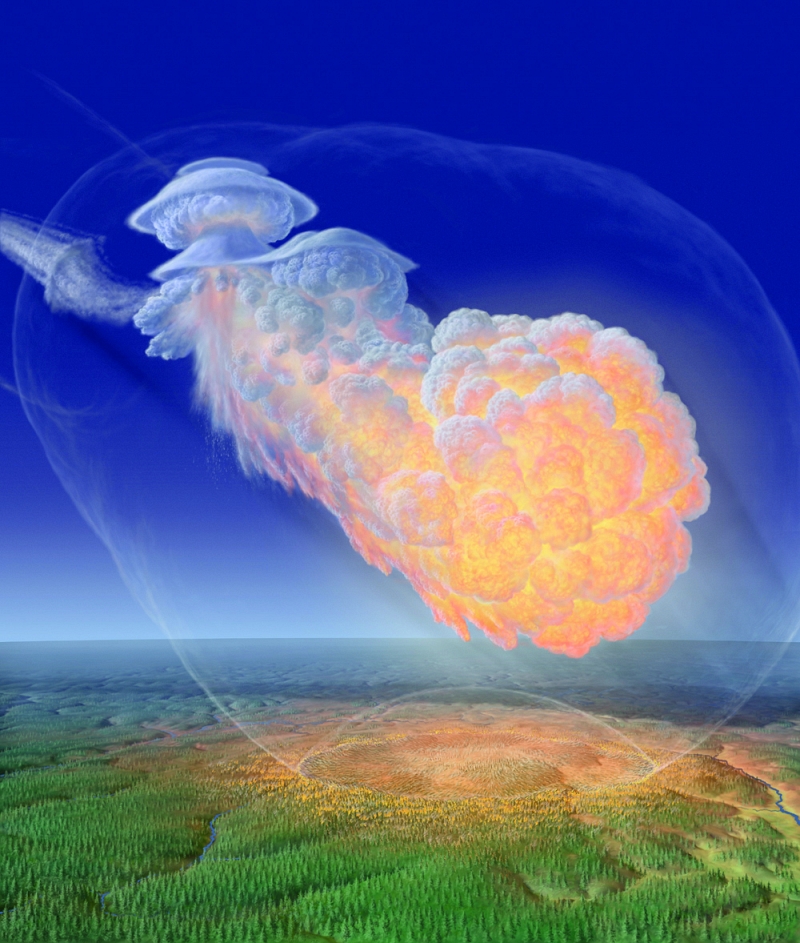Skyfall
Every year 15 000 tons of meteorites fall down to Earth; a 25-kilogramme rock landed near the city of Razgrad
In 1772, following the proposal of Antoine Lavoisier, the Paris Academy of Sciences announced that "rocks cannot fall from the sky, because there are no rocks in the sky". Just 35 years later a huge meteor shower rained down the United States. The professors Kingsley and Silliman prepared a detailed report of the event but the US president Thomas Jefferson refused to believe them and even called them liars. Well, it is obvious that even prominent figures such as the great chemist and the author of the Declaration of Independence can be wrong.
It turned out that not only rocks but also iron pieces could well fall from the sky. Oftentimes, that could be a fearsome sight, as we all saw recently documented in the pictures taken above the Russian city of Chelyabinsk. Those photos looked as if they had been taken from a science-fiction movie... What is the origin of these objects? Besides the eight big planets and their satellites, the Solar system family includes hundreds of thousands of asteroids and comets as well. An uncountable number of smaller objects- meteoric bodies or meteorites are also orbiting our star.

HANGING IN THE AIR
There are no universally accepted meteor size standards, but nonetheless, we are talking about objects with dimensions ranging from a small grain of sand, to a 10-storey residential building. If they are bigger they are referred to as asteroids and comet nuclei, and when they are smaller- as cosmic dust.
Meteoric bodies orbit around the Sun with a speed of tens of kilometres per second. Some of them were formed after a collision between the smaller planets while others come from comets forming the so-called meteoroid streams or clusters. Biela's comet, for example, fell into pieces as far back as 1848. Nowadays the Bielids (or Andromedids) stream is all that reminds us of it. The meteor showers Eta Aquarids and Orionids are related to the famous Halley's Comet.
We observe the "falling star" or "meteor" (from Greek „μετέωρος"- hanging in the air) phenomenon, when the paths of the smaller meteoric bodies cross the orbit of the Earth. A falling star is the short-lived trail of light as the meteorite burns in the atmosphere (usually at a height of 80-100 km). In fact, we do not see the actual meteoric bodies but the radiation of the excited and ionized atoms of their material. Observing it provides us with invaluable information; specialists can determine the amount of the falling matter, what the threat to spacecraft is, etc. Every year around 15 000 tons of meteoric material falls down on the Earth.
FALLEN STARS
The belief that one has to make a wish when seeing a meteor is not only Bulgarian. When the future notable atom physicist Max Born was sitting an exam in astronomy, the famous scientist Schwarzschild asked him: "What do you do when you see a falling star?"
Born knew very well what he was supposed to answer, but he could not help but answer: "I make a wish".
Meteors, brighter than minus four star magnitude, are called bolides. The extremely bright ones are as bright as the Sun and are observed when large meteoric bodies enter the atmosphere. Usually, most of the meteor burns out in the atmosphere, but the occasional piece could reach the Earth's surface. These pieces of "celestial matter" are called meteorites. Depending on the angle of the attack, their speed can be more or less reduced by air resistance. If the speed of the fall is high, there could be an explosion forming a meteor crater. One of the biggest ones is the one in Arizona, USA. Its depth is 200m, and its diameter- 1200m.
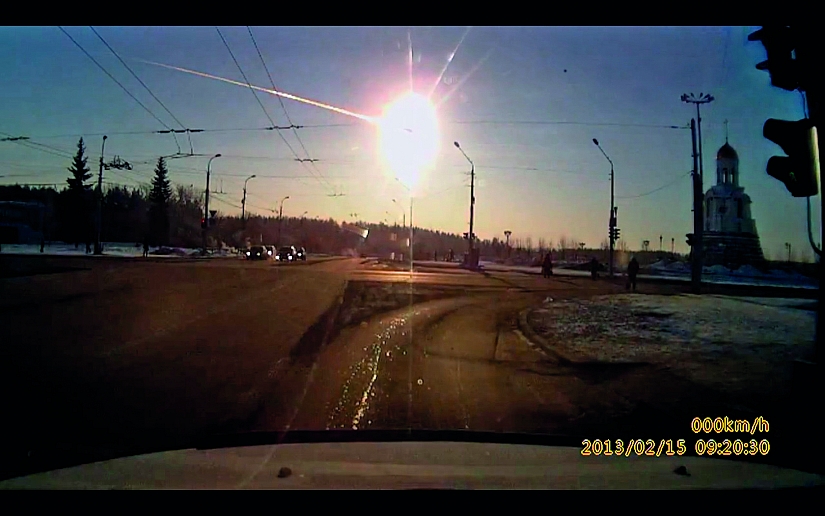
One of them was so strong that it caused an earthquake. The epicentre of the quake was 1km southwest of the city. The shock wave broke the windows in six towns and four villages, with Chelyabinsk suffering the greatest damage. More than 1000 people were injured, mostly by the broken glass. Over 4000 buildings were damaged. Many walls were destroyed, while the roof and one of the walls of the Zink factory were carried away.
The mass of the cosmic invader was more than 10 tons, its diameter- 10m and its speed upon entering the atmosphere-around 15 km per second. According to Russian experts, the explosion occurred at a height of round 30 km. Its power was estimated at the equivalent of approximately 50 kilotons of TNT – more than that of the bomb dropped on Hiroshima. Almost 25 000 people were engaged in the clearing-up operations.
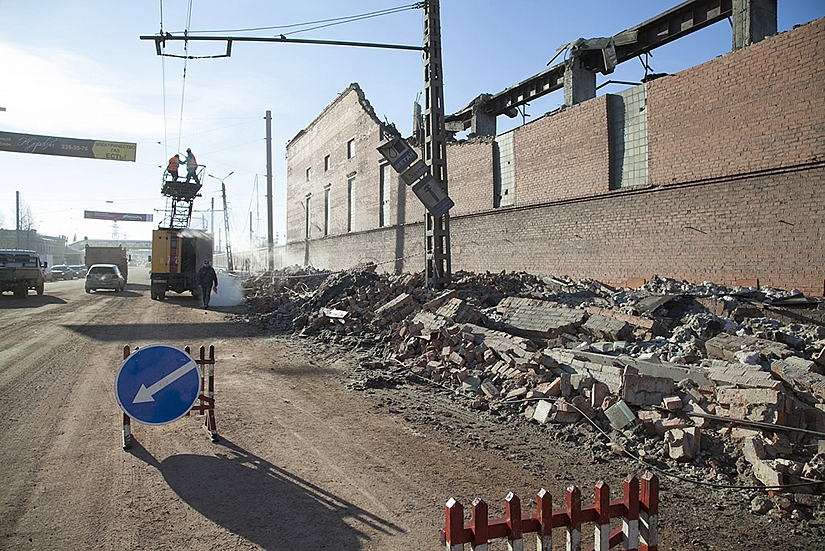
THE TUNGUSKA MIRACLE
When we hear the word "meteorite", it is usually the so-called Tunguska event that comes to mind. In the early morning of June 30th 1908m a huge bolide, brighter than the Sun, flew over Eastern Siberia. It was accompanied by a thunderous rumble followed by an explosion. The invader from space exploded over the area of Podkamennaya Tunguska River. Windows in villages, tens or even hundreds of kilometres away were broken by the shock wave. It was possible to hear the explosion at a distance of as much as 1000km. It was so powerful that it caused an earthquake.
600km away from the scene of the explosion, the engine driver of the Trans-Siberian Express stopped the train, because he assumed that some of the wagons had exploded. The explosive wave went around the whole globe. More than 200 square kilometres of taiga had been felled down; the roots of the trees pointing towards the epicentre of the explosion.
Numerous expeditions after that did not find any crater, or debris.
Therefore, it is not strictly correct to refer to the incident as the Tunguska meteorite; it was rather a phenomenon, or if you wish, a miracle, because a lot of anomalies and strange geophysical phenomena have occurred. The explosion gave rise to various exotic theories - that Earth encountered a piece of anti-matter; that an alien ship exploded above Podkamennaya Tunguska, etc. The most likely explanation would be that a part of the nucleus of Encke's comet exploded at a height of around 10km above the Earth's surface,. Whatever the phenomenon was, it is good it did not happen four hours later. Because then, as the Earth spins, the site of the explosion would have been St. Petersburg...

an archive picture of Tonguska miracle
STONY IRON
Depending on their content, meteorites approaching the Earth's surface are divided into stony, iron or stony-iron (in scientific language- aerolites, siderites and siderolites). Most of them contain small spherical or elliptic particles and are called chondrites. The majority of meteorites are stony - around 93%. But the biggest "guest from space" was made of iron.
That is the Hoba meteorite, which fell in ancient times on the territory of present-day Namibia in Southwest Africa. Its weight was 60 tons.
Meteorites have also fallen on Bulgarian territory. The fantastic Belogradchik rocks are widely known. But probably few have heard about the Belogradchik meteorite. Professor Borislav Toshev reminded us about it recently. It fell near the village of Vurba on May 20th (June 1st) 1873. It was accompanied by a loud thunder. Its weight was nearly 4 kilograms and it bore a metre deep into the earth.
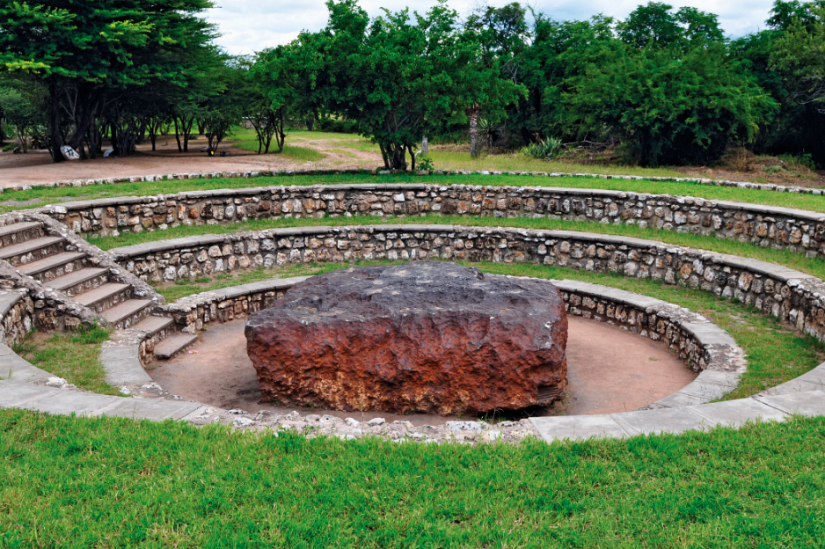
The Hoba meteorite in Namibia is a tourist attraction
POOR AIM
Sometimes, falling objects nearly take their death toll. According to press releases, on the 25th of April last year, Dimitar Grantcharov was almost hit by a meteorite. The incident happened in the Strumyani region, near Blagoevgrad, while the man was walking his dog.
Mr. Grantcharov had a narrow escape, but at least two other people were injured. On November 30th 1954, a meteorite with a weight of 1.4kg broke through the roof of a house in Alabama, bounced off the radio and fell on the sleeping Ann Hodges. Its speed had already been significantly decreased, so Mrs. Hodges got away with just a large bruise.
Gerrit Blank from the German city of Essen got hurt on June 5th 2009 on his way to school. A small meteorite (the size of a pea) scratched his hand, after that hitting the ground. Gerrit was lucky as well. He got away with a 7.5cm burn-injury, because as a result of its high speed, the meteorite was still hot.

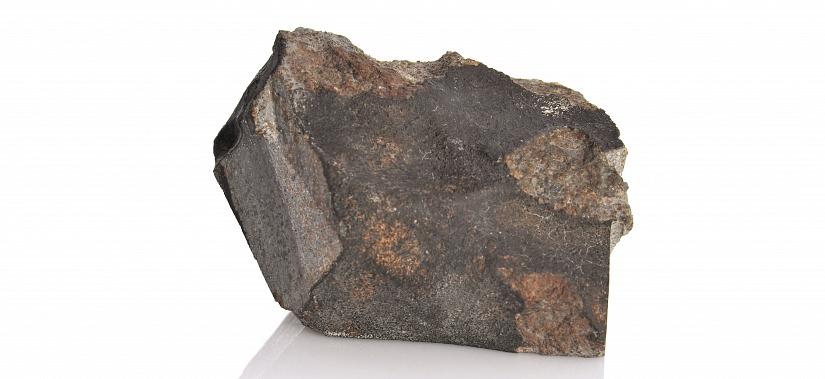
The meteorites from Debnevo (left) and Gumoshtnik- near the city of Troyan, can be seen in the Sofia University
BG VISITORS
Here is a part of the description given by the prominent meteorite scientist Walter Flight (1841-1885) concerning the Belogradchik meteorite:
"It is covered by a black crust, under which, a meteorite with light grey and very fine-grained structure can be observed; it is with iron grains, disperged within the mass of the sample. The microscopic studies show that the rock mass is transparent and almost colourless, with rock particles interfering with polarized light. The metal part consists of nickel and iron. (...) The silicon components (...) indicate presence of olivine. (...) The meteorite shows some relation to other meteorites, such as the one from Luc, France (September 13th 1768) and others."
Unfortunately, at present, there is not a single piece of the Belogradchik meteorite in Bulgaria. Fragments of it are exhibited in the natural history museums in Berlin, Vienna, Paris and Chicago, in the Vatican meteorite collection and in the British Museum. The biggest piece (3040 grams) is preserved at the Museum of Natural History in Budapest.
Meteorites are named after the places where they fell, therefore, in the specialized literature, the Belogradchik meteorite is referred to as Vyrba, Wirba, Urba, Vidin or Belgradjek.
The story of the Paris fragment is an interesting one. It is a present from the ambassador of the Sublime Porte in France at the time - Savphet Pasha- the same one, who signed the Treaty of San Stefano in 1878 as a representative of Sultan Abdul Hamid II.
In 1740, the biggest "Bulgarian meteorite" fell near the city of Razgrad. It weighed almost 25kg, but its current location is unknown. The other meteorites which have fallen on our territory are preserved at the Museum of Mineralogy, part of the Faculty of Geology and Geography of Sofia University. They are: Debnevo and Gumoshtnik (the region of Troyan, 1904, around 6kg); Silistra (1917); Konyovo (Nova Zagora region, 1931); Pavel (Polski Drambesh region, 1966).
The "Black stone" in the "Kaaba" temple in Mecca, extremely valued by Muslims, is probably also with meteorite origin.
The beautiful meteorite, which fell near the Argentinean city of Esquel Below: the iron column near Delhi.
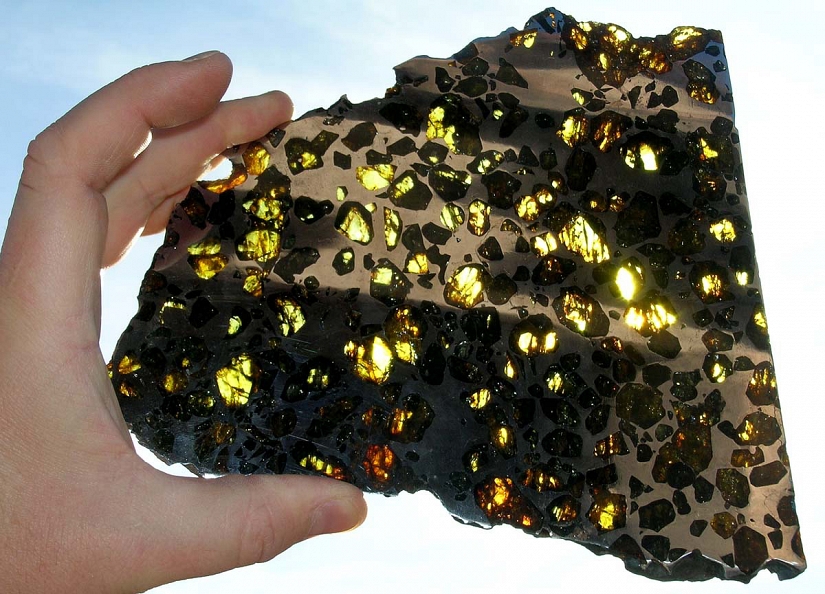
The beautiful meteorite, fallen near the Argentinian city of Esquel
THE GOD - STONE
Evidence of meteorites has been around for millennia. The first written account dates back to 664 B.C. A passage from the Bible can also be interpreted as evidence for a heavy meteor shower: "And as they fled before Israel, while they were going down the ascent of Beth-horon, the LORD threw down large stones from heaven on them as far as Azekah, and they died. There were more who died because of the hailstones than the sons of Israel killed with the sword." (Joshua 10:11). In ancient times, meteorites were often deified. Emperor Marcus Aurelius Antoninus Augustus (III century A.C.) declared a big black piece for a symbol of the Phoenician- Syrian Sun God Elagabalus and adopted the name of the divinity. Archduke Maximilian, the future emperor of the Holy Roman Empire, regarded a stony meteorite which fell in 1942 as his personal talisman. He had it nailed to the wall of the church, so that it would not be able to fly back.
The "Black stone" in the "Kaaba" temple in Mecca, an object of worship by Muslims, is probably also with meteorite origin. Iron meteorites have been objects of worship as well. They were used to make talismans, amulets and weapons. A dagger in the tomb of Tutankhamun (XIV B.C.), a gift from the Hittites, was without a doubt made of meteorite iron. So were King Solomon's ring and Alexander the Great's crown. The rulers considered the objects to have magical properties and never parted with them. According to legend, the weapons and the armour of the great conquerors Attila and Tamerlane, as well as the sword of King Arthur Excalibur, also had heavenly origin.
The iron column near Delhi is 7m tall and weighs more than six tons. It is famous with the fact that it has virtually not rusted for 1600 years. One of the explanations for this phenomenon is that it was made of meteorite iron as well.
Fossil-like structures in ALH 84001 can be seen only under a microscope, but they give us a reason to believe that there was life on ancient Mars- at least primitive microorganisms
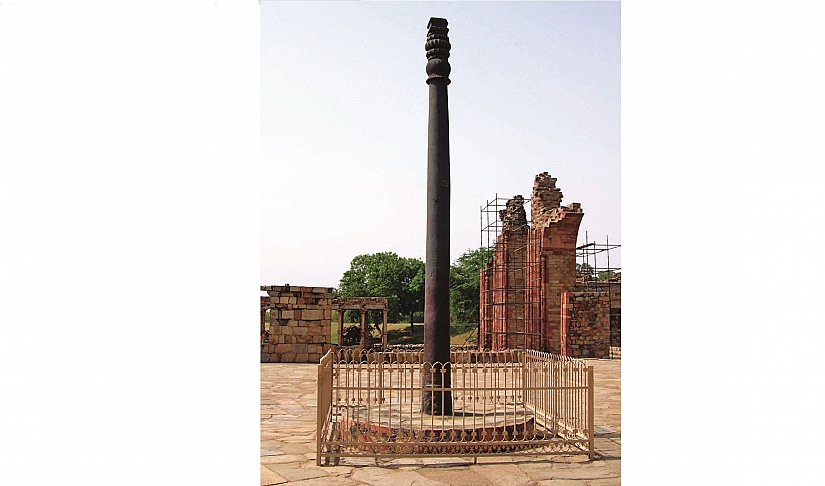
The iron column near Delhi
FLYING SAUCERS
What happened near Chelyabinsk gave the rise of many conspiracy theories. The most exotic one is that the meteorite was burst by a flying saucer. According to another, the government knew about the upcoming event, but did not warn the population so as to avoid panic. The famous Russian politician, Vladimir Zhirinovsky claimed that it had all been caused by the Americans testing a new weapon. The pieces discovered in the area of Cherbakul Lake near Chelyabinsk, however, prove that it was a stony meteorite, a common chondrite. What the incident has proven is that that we have to do all within our powers to find and monitor not only the large asteroids, but the smaller yet closer to Earth objects. That is something, which unfortunately, we have not had the technology to do- some of these objects are untraceable by today's standards of observation.
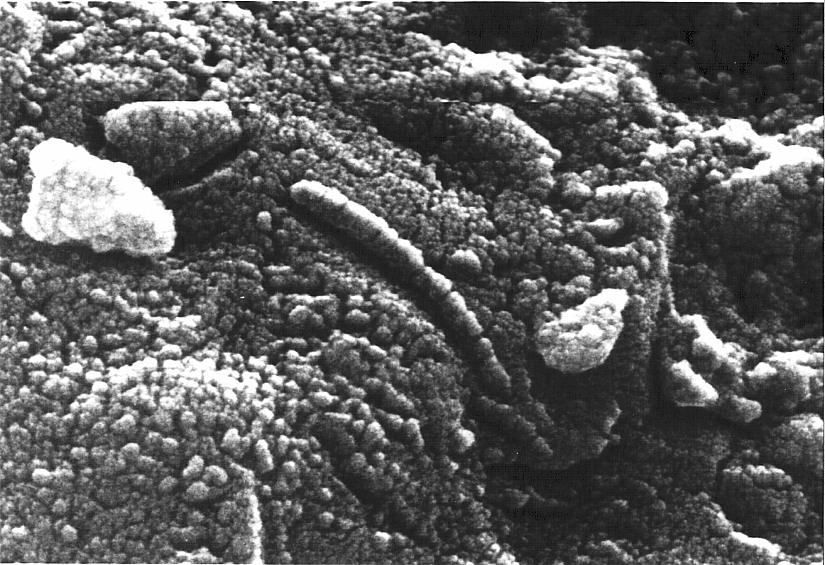
The similar to fossil structures in ALH 84001 can be seen only under a microscope, but they give us a reason to believe that there was life on ancient Mars- at least primitive microorganisms
A FRIEND FROM MARS
Sometimes, meteorites can be a pleasant surprise. Such was the case with Allan Hills 84001. It was stony, weighing around 2kg. It was found in Antarctica in 1984. Its chemical content matches the one of the samples obtained by the "Viking" space probe, which explored Mars in 1976. Supposedly, a huge meteorite hit the Red planet with such a shock, that the blasted piece of rock overcame the planet's gravity. NASA scientists discovered that the meteorite contained microscopic fossils. These fossil-like structures shared uncanny similarities to the fossils of Earth bacteria. Contamination, after falling on our planet, is impossible- there were no such fossils in the other meteors found in Antarctica.
Furthermore, the concentration of organic molecules was greater towards the core of the meteorite. If it had been contaminated on Earth, it would have been the other way around. And so it turns out that the heavens still keep many secrets which can surprise and even endanger us. It is sheer luck that so far we have successfully avoided any serious incidents and that there have been no casualties, but we cannot only rely on luck. When it is the heavens that are threatening us, we need a far more reasonable approach...
It turned out that not only rocks but also iron pieces could well fall from the sky. Oftentimes, that could be a fearsome sight, as we all saw recently documented in the pictures taken above the Russian city of Chelyabinsk. Those photos looked as if they had been taken from a science-fiction movie... What is the origin of these objects? Besides the eight big planets and their satellites, the Solar system family includes hundreds of thousands of asteroids and comets as well. An uncountable number of smaller objects- meteoric bodies or meteorites are also orbiting our star.

HANGING IN THE AIR
There are no universally accepted meteor size standards, but nonetheless, we are talking about objects with dimensions ranging from a small grain of sand, to a 10-storey residential building. If they are bigger they are referred to as asteroids and comet nuclei, and when they are smaller- as cosmic dust.
Meteoric bodies orbit around the Sun with a speed of tens of kilometres per second. Some of them were formed after a collision between the smaller planets while others come from comets forming the so-called meteoroid streams or clusters. Biela's comet, for example, fell into pieces as far back as 1848. Nowadays the Bielids (or Andromedids) stream is all that reminds us of it. The meteor showers Eta Aquarids and Orionids are related to the famous Halley's Comet.
We observe the "falling star" or "meteor" (from Greek „μετέωρος"- hanging in the air) phenomenon, when the paths of the smaller meteoric bodies cross the orbit of the Earth. A falling star is the short-lived trail of light as the meteorite burns in the atmosphere (usually at a height of 80-100 km). In fact, we do not see the actual meteoric bodies but the radiation of the excited and ionized atoms of their material. Observing it provides us with invaluable information; specialists can determine the amount of the falling matter, what the threat to spacecraft is, etc. Every year around 15 000 tons of meteoric material falls down on the Earth.
FALLEN STARS
The belief that one has to make a wish when seeing a meteor is not only Bulgarian. When the future notable atom physicist Max Born was sitting an exam in astronomy, the famous scientist Schwarzschild asked him: "What do you do when you see a falling star?"
Born knew very well what he was supposed to answer, but he could not help but answer: "I make a wish".
Meteors, brighter than minus four star magnitude, are called bolides. The extremely bright ones are as bright as the Sun and are observed when large meteoric bodies enter the atmosphere. Usually, most of the meteor burns out in the atmosphere, but the occasional piece could reach the Earth's surface. These pieces of "celestial matter" are called meteorites. Depending on the angle of the attack, their speed can be more or less reduced by air resistance. If the speed of the fall is high, there could be an explosion forming a meteor crater. One of the biggest ones is the one in Arizona, USA. Its depth is 200m, and its diameter- 1200m.

The Chelyabinsk danger
Up to recently, metorite damage in cities could only be seen in American movies. As we all know, however, on February 15th 2013 the area of Chelyabinsk near the Russian mountain of Ural was under a "meteor attack". Similarly to the Tunguska body, the meteorite exploded in the air. The phenomenon was observed in the areas of Sverdlovsk, Kurgan and Tyumen, in Bashkiria and Kazakhstan. There were a few explosions.One of them was so strong that it caused an earthquake. The epicentre of the quake was 1km southwest of the city. The shock wave broke the windows in six towns and four villages, with Chelyabinsk suffering the greatest damage. More than 1000 people were injured, mostly by the broken glass. Over 4000 buildings were damaged. Many walls were destroyed, while the roof and one of the walls of the Zink factory were carried away.
The mass of the cosmic invader was more than 10 tons, its diameter- 10m and its speed upon entering the atmosphere-around 15 km per second. According to Russian experts, the explosion occurred at a height of round 30 km. Its power was estimated at the equivalent of approximately 50 kilotons of TNT – more than that of the bomb dropped on Hiroshima. Almost 25 000 people were engaged in the clearing-up operations.

THE TUNGUSKA MIRACLE
When we hear the word "meteorite", it is usually the so-called Tunguska event that comes to mind. In the early morning of June 30th 1908m a huge bolide, brighter than the Sun, flew over Eastern Siberia. It was accompanied by a thunderous rumble followed by an explosion. The invader from space exploded over the area of Podkamennaya Tunguska River. Windows in villages, tens or even hundreds of kilometres away were broken by the shock wave. It was possible to hear the explosion at a distance of as much as 1000km. It was so powerful that it caused an earthquake.
600km away from the scene of the explosion, the engine driver of the Trans-Siberian Express stopped the train, because he assumed that some of the wagons had exploded. The explosive wave went around the whole globe. More than 200 square kilometres of taiga had been felled down; the roots of the trees pointing towards the epicentre of the explosion.
Numerous expeditions after that did not find any crater, or debris.
Therefore, it is not strictly correct to refer to the incident as the Tunguska meteorite; it was rather a phenomenon, or if you wish, a miracle, because a lot of anomalies and strange geophysical phenomena have occurred. The explosion gave rise to various exotic theories - that Earth encountered a piece of anti-matter; that an alien ship exploded above Podkamennaya Tunguska, etc. The most likely explanation would be that a part of the nucleus of Encke's comet exploded at a height of around 10km above the Earth's surface,. Whatever the phenomenon was, it is good it did not happen four hours later. Because then, as the Earth spins, the site of the explosion would have been St. Petersburg...

an archive picture of Tonguska miracle
STONY IRON
Depending on their content, meteorites approaching the Earth's surface are divided into stony, iron or stony-iron (in scientific language- aerolites, siderites and siderolites). Most of them contain small spherical or elliptic particles and are called chondrites. The majority of meteorites are stony - around 93%. But the biggest "guest from space" was made of iron.
That is the Hoba meteorite, which fell in ancient times on the territory of present-day Namibia in Southwest Africa. Its weight was 60 tons.
Meteorites have also fallen on Bulgarian territory. The fantastic Belogradchik rocks are widely known. But probably few have heard about the Belogradchik meteorite. Professor Borislav Toshev reminded us about it recently. It fell near the village of Vurba on May 20th (June 1st) 1873. It was accompanied by a loud thunder. Its weight was nearly 4 kilograms and it bore a metre deep into the earth.

The Hoba meteorite in Namibia is a tourist attraction
POOR AIM
Sometimes, falling objects nearly take their death toll. According to press releases, on the 25th of April last year, Dimitar Grantcharov was almost hit by a meteorite. The incident happened in the Strumyani region, near Blagoevgrad, while the man was walking his dog.
Mr. Grantcharov had a narrow escape, but at least two other people were injured. On November 30th 1954, a meteorite with a weight of 1.4kg broke through the roof of a house in Alabama, bounced off the radio and fell on the sleeping Ann Hodges. Its speed had already been significantly decreased, so Mrs. Hodges got away with just a large bruise.
Gerrit Blank from the German city of Essen got hurt on June 5th 2009 on his way to school. A small meteorite (the size of a pea) scratched his hand, after that hitting the ground. Gerrit was lucky as well. He got away with a 7.5cm burn-injury, because as a result of its high speed, the meteorite was still hot.


The meteorites from Debnevo (left) and Gumoshtnik- near the city of Troyan, can be seen in the Sofia University
BG VISITORS
Here is a part of the description given by the prominent meteorite scientist Walter Flight (1841-1885) concerning the Belogradchik meteorite:
"It is covered by a black crust, under which, a meteorite with light grey and very fine-grained structure can be observed; it is with iron grains, disperged within the mass of the sample. The microscopic studies show that the rock mass is transparent and almost colourless, with rock particles interfering with polarized light. The metal part consists of nickel and iron. (...) The silicon components (...) indicate presence of olivine. (...) The meteorite shows some relation to other meteorites, such as the one from Luc, France (September 13th 1768) and others."
Unfortunately, at present, there is not a single piece of the Belogradchik meteorite in Bulgaria. Fragments of it are exhibited in the natural history museums in Berlin, Vienna, Paris and Chicago, in the Vatican meteorite collection and in the British Museum. The biggest piece (3040 grams) is preserved at the Museum of Natural History in Budapest.
Meteorites are named after the places where they fell, therefore, in the specialized literature, the Belogradchik meteorite is referred to as Vyrba, Wirba, Urba, Vidin or Belgradjek.
The story of the Paris fragment is an interesting one. It is a present from the ambassador of the Sublime Porte in France at the time - Savphet Pasha- the same one, who signed the Treaty of San Stefano in 1878 as a representative of Sultan Abdul Hamid II.
In 1740, the biggest "Bulgarian meteorite" fell near the city of Razgrad. It weighed almost 25kg, but its current location is unknown. The other meteorites which have fallen on our territory are preserved at the Museum of Mineralogy, part of the Faculty of Geology and Geography of Sofia University. They are: Debnevo and Gumoshtnik (the region of Troyan, 1904, around 6kg); Silistra (1917); Konyovo (Nova Zagora region, 1931); Pavel (Polski Drambesh region, 1966).
The "Black stone" in the "Kaaba" temple in Mecca, extremely valued by Muslims, is probably also with meteorite origin.
The beautiful meteorite, which fell near the Argentinean city of Esquel Below: the iron column near Delhi.

The beautiful meteorite, fallen near the Argentinian city of Esquel
THE GOD - STONE
Evidence of meteorites has been around for millennia. The first written account dates back to 664 B.C. A passage from the Bible can also be interpreted as evidence for a heavy meteor shower: "And as they fled before Israel, while they were going down the ascent of Beth-horon, the LORD threw down large stones from heaven on them as far as Azekah, and they died. There were more who died because of the hailstones than the sons of Israel killed with the sword." (Joshua 10:11). In ancient times, meteorites were often deified. Emperor Marcus Aurelius Antoninus Augustus (III century A.C.) declared a big black piece for a symbol of the Phoenician- Syrian Sun God Elagabalus and adopted the name of the divinity. Archduke Maximilian, the future emperor of the Holy Roman Empire, regarded a stony meteorite which fell in 1942 as his personal talisman. He had it nailed to the wall of the church, so that it would not be able to fly back.
The "Black stone" in the "Kaaba" temple in Mecca, an object of worship by Muslims, is probably also with meteorite origin. Iron meteorites have been objects of worship as well. They were used to make talismans, amulets and weapons. A dagger in the tomb of Tutankhamun (XIV B.C.), a gift from the Hittites, was without a doubt made of meteorite iron. So were King Solomon's ring and Alexander the Great's crown. The rulers considered the objects to have magical properties and never parted with them. According to legend, the weapons and the armour of the great conquerors Attila and Tamerlane, as well as the sword of King Arthur Excalibur, also had heavenly origin.
The iron column near Delhi is 7m tall and weighs more than six tons. It is famous with the fact that it has virtually not rusted for 1600 years. One of the explanations for this phenomenon is that it was made of meteorite iron as well.
Fossil-like structures in ALH 84001 can be seen only under a microscope, but they give us a reason to believe that there was life on ancient Mars- at least primitive microorganisms

FLYING SAUCERS
What happened near Chelyabinsk gave the rise of many conspiracy theories. The most exotic one is that the meteorite was burst by a flying saucer. According to another, the government knew about the upcoming event, but did not warn the population so as to avoid panic. The famous Russian politician, Vladimir Zhirinovsky claimed that it had all been caused by the Americans testing a new weapon. The pieces discovered in the area of Cherbakul Lake near Chelyabinsk, however, prove that it was a stony meteorite, a common chondrite. What the incident has proven is that that we have to do all within our powers to find and monitor not only the large asteroids, but the smaller yet closer to Earth objects. That is something, which unfortunately, we have not had the technology to do- some of these objects are untraceable by today's standards of observation.

The similar to fossil structures in ALH 84001 can be seen only under a microscope, but they give us a reason to believe that there was life on ancient Mars- at least primitive microorganisms
A FRIEND FROM MARS
Sometimes, meteorites can be a pleasant surprise. Such was the case with Allan Hills 84001. It was stony, weighing around 2kg. It was found in Antarctica in 1984. Its chemical content matches the one of the samples obtained by the "Viking" space probe, which explored Mars in 1976. Supposedly, a huge meteorite hit the Red planet with such a shock, that the blasted piece of rock overcame the planet's gravity. NASA scientists discovered that the meteorite contained microscopic fossils. These fossil-like structures shared uncanny similarities to the fossils of Earth bacteria. Contamination, after falling on our planet, is impossible- there were no such fossils in the other meteors found in Antarctica.
Furthermore, the concentration of organic molecules was greater towards the core of the meteorite. If it had been contaminated on Earth, it would have been the other way around. And so it turns out that the heavens still keep many secrets which can surprise and even endanger us. It is sheer luck that so far we have successfully avoided any serious incidents and that there have been no casualties, but we cannot only rely on luck. When it is the heavens that are threatening us, we need a far more reasonable approach...

